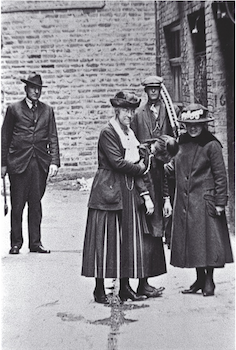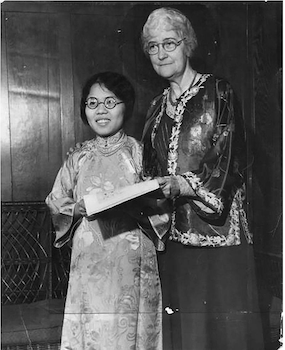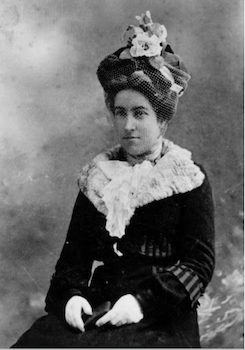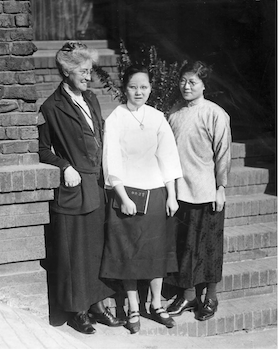
Donaldina Cameron was born on July 26th, 1869 in Otago Land District on the South Island of New Zealand to Allan Cameron and Isabella Mackenzie. Her parents were descendants of Scottish Highland sheep ranchers and had come to New Zealand a few years before her birth. As the youngest of seven children, she spent her time on sheep ranches, since her father was a sheep rancher. Despite her family being very large, they were very close knit. In fact, the second eldest sister, Annie, acted as a second mother to Cameron. In 1871, Cameron’s family moved to San Joaquin Valley in California, as sheep raising looked more desirable to Cameron’s father. However, in 1874, when Cameron was just five years old, her mother passed away. While Cameron’s father worked for other sheep ranchers, her older sisters looked after her. The family then moved to Oakland in 1878, and later to La Puente, near Los Angeles, in 1885. As for her education, Cameron attended Castleman School for Girls in San Joaquin, went to high school in Oakland, and continued on to go to the college Los Angeles Normal School, to become a teacher. Tragically, her father died in 1887, causing Cameron to drop out of the college and go live with her siblings in La Puente. When she was 19 years old, she was briefly engaged to her elder brother’s friend, but they soon broke off their engagement for unknown reasons.
In 1882, the Chinese Exclusion Act was passed by the US Congress, effectively banning Chinese people from immigrating to the US. Chinese immigrants could only go through the border by proving that they were married to an American-born Chinese man or that they had Chinese-American relatives residing in the US. This led to many endeavors to forge paperwork to let Chinese immigrants through. Furthermore, many Chinese women were tricked into traveling to the US, often being led to believe they were being arranged to marry Chinese-American men, and that there would be better opportunities there. Instead, they would find themselves forced into the sex trafficking industry, trapped in phony “contracts” that would make it virtually impossible to leave. The women were treated as human cargo, put in appalling conditions, and often physically abused. This scheme was organized by Chinese secret societies called “tongs,” and this period in history came to be known as the Yellow Slave Trade. In 1874, missionaries of the Presbyterian Church, who were concerned, founded the “Occidental Mission Home for Girls” in San Francisco’s Chinatown to rescue and teach these Chinese women Christian values.
In April of 1895, when Cameron was 25 years old, a family friend, Mrs. P. D. Brown—a former president of the Women’s Occidental Board of Foreign Missions and founder of the Young Women’s Christian Association Branch in San Francisco—brought her to the Mission Home, hoping to inspire her to work there. Cameron had recently broken off her engagement and dropped out of teacher school. After hearing about the suffering of Chinese girls in Chinatown, she agreed to volunteer, thinking she’d only be there for a year.

At the time that Cameron joined, she was second-in-command to the superintendent, Margaret “Maggie” Culbertson, as well as a sewing teacher. Two years later, in 1897, Culbertson died. From 1897 to 1900, Cameron worked under Mary H. Field, who had replaced Culbertson, but when Field resigned in 1900, Cameron took over as superintendent. Soon after, Cameron got engaged with a student at Princeton Seminary, but due to the prioritization of their religious work, they broke it off. Since the time that Cameron joined, she went on many dangerous rescue missions at brothels to save trapped Chinese girls, who were forced into prostitution. At first, she accompanied Culbertson to assist her, but continued on her own following her death. Cameron was known for being very kind and caring, and was very close with the Chinese girls she rescued. She would embrace their culture by integrating Chinese dishes and decorations in the Home. Cameron also took on the role of being the girls’ official guardian, often going to court to fight for guardianship over certain girls. She took on various nicknames from different groups: “White Devil” or “Fahn Quai” by brothel owners, “Lo Mo” or “Little Mother” by the rescued Chinese girls, and “Aunt Dolly” by her family.
At the Home, Chinese girls were taught housekeeping, attended classes, and learned Christian principles. The Home also housed children of Chinese prostitutes. Believing it was the best way to give the girls new lives, they were expected to convert to Christianity and engage in daily morning Bible study, evening prayers, and Sunday School. Regardless, girls could leave the Home at any time if they wished to. With money constantly being a struggle, Cameron often hosted around 20 guests everyday to socialize and interact with the Home’s residents. The Home had very strict rules that adhered to its Presbyterian values and guaranteed the women’s safety. Residents needed permission from staff to go outside, so they had very little contact with the outside world. This protected them from potentially being harmed or taken back by brothel members. In addition, women could only marry Christian men chosen by Cameron and her staff. When a resident found a suitor to marry, she had to wear a white wedding dress, as opposed to the traditional red wedding dress worn in Chinese culture.
Cameron was notable for her exceptional bravery and determination in rescuing the Chinese girls. Throughout her life, she had faced persistent threats from brothel owners on her life, and on the first day of teaching, dynamite sticks were found on the Home’s property. However, she was determined to continue her work. Cameron and her staff would easily get locations of hostage Chinese girls through secret messages from the girls’ relatives and friends. She and her team would strategically rescue them through disguises and finding hidden trapdoors and staircases. They would also regularly report certain locations for police officers to investigate or be accompanied on their rescues. In 1900, due to the fear of bubonic plague, the police quarantined Chinatown streets with blockades. Nevertheless, Cameron “made her way from people’s roofs and basements, up and down, and found her way” to get to a girl she wanted to save.

In another instance, on March 29th, 1900, two Chinese men and a police officer arrived at the Home demanding for Kum Quai, claiming she was a thief. Since Cameron was accustomed to this tactic, she went with Quai on the train to Palo Alto so she wouldn’t be alone. They were locked overnight in a prison cell, and at 2AM, when a suspicious deputy tried opening the door, Cameron barricaded themselves until officers were breaking the doors. Quai was kidnapped in a buggy, with Cameron desperately trying to follow but to no avail. Panicked, she went to townspeople telling them what happened and asking for help. The news spread in Palo Alto, with more and more people getting upset about the situation. A manifestation by Stanford University students and Palo Alto residents was organized in San Jose, where the lawyer representing the men was practicing. A community meeting supporting Cameron and Quai was also assembled, and justice was served. The men were punished, the Home got even more support, and Cameron got guardianship of Quai.
Cameron was strongly against racist attitudes toward Chinese people. She was very accepting of the Chinese girls, while upholding her values and leadership at the Home. Although she lived in Chinatown for 40 years, she never learned Chinese, and relied heavily on her Chinese aides for translation. One girl, Tien Wu, had arrived at the Home before Cameron, and was very scared of her. However, after one of Cameron’s aides passed away, “she came in and just threw herself against her bed and sobbed and sobbed and sobbed.” From the next day, Tien Wu began working as one of her aides, and they became very close. They kept close until Cameron’s death, continuing to live next door when Cameron was an elderly woman living in Palo Alto.
In 1925, Cameron founded a home in Oakland that served as a refuge for young children. She also founded two other homes for children of the Chinese women and for Chinese orphans: Chung Mei Home for young boys, and Ming Quong Home for young girls. On April 18th, 1906, a big earthquake struck San Francisco, waking the Home’s residents in the morning. Cameron and the Home’s residents found refuge in the East Bay. Meanwhile, the Home was destroyed by dynamite in an attempt to stop the fire in San Francisco from growing, and was gradually rebuilt. In 1911, Cameron married Nathaniel Tooker, a widower who supported her missionary work, but he died in July of the same year. In 1934, Cameron retired following the National Board of the Mission Home’s mandatory retirement age of 65. However, she stayed in San Francisco to assist her successor, Lorna Logan, and to continue volunteering. In 1939, she went to Oakland to look after her three older unmarried sisters, and moved back to Palo Alto in 1942 with her two surviving sisters. In 1968, at 98 years old, Cameron died from a pulmonary embolism.

Cameron’s work has made a lasting impact on many. Bessie Jeong, who escaped to the Home as a teen in 1916, became the first Chinese woman to graduate from Stanford University, and in the early 1930s, was one of the first female Chinese American doctors in the US. It is estimated that Cameron helped over 3,000 Chinese women and children throughout her life. In 1942, the Occidental Mission Home was renamed the Donaldina Cameron House, with her consent. In 1969, the California State Legislature presented a memorial tribute for Cameron’s efforts, presented by Assemblywoman March Fong, who described Cameron as a “distinguished Californian” who “will be remembered for the…integral part which she played in the history of San Francisco and the Chinese community.” Ron Cameron, Cameron’s great nephew, remembers going by her home to wish her a happy birthday when she was an elderly lady, and “would have to get in a line that was about two blocks long of Chinese people who had driven…to wish her a happy birthday…Many of them had their kids with them, and they all gave her cards…after she died we cleaned out her house, there were sacks and sacks of cards like that.” The Donaldina Cameron House still exists in San Francisco to this day, at the same location, giving support to Chinese women and their children through Presbyterian doctrine.
Cameron’s story is so impactful today as throughout her life, she remained committed to her work, regardless of the obstacles she had to face. Even when the San Francisco earthquake struck in 1906 and the Home was destroyed, she was successful in keeping the Chinese girls safe, and everything returned to normal after it was rebuilt. Even in a male-dominated town filled with illegal activity that abused women, she remained strong and authoritative, going against powerful men to protect the Chinese girls in court and in the streets.
Why Did I Choose to Research Donaldina Cameron?
I first heard about Donaldina Cameron when reading the book, “The Paper Daughters of Chinatown,” by Heather B. Moore. Learning about the human trafficking of these Chinese girls was shocking to me, as I had never heard of this moment in history before. I was so inspired by Cameron’s work and bravery in helping so many of their lives, even though she had no obligation to, that I decided I had to write an article about her so that more people know her story.
Works Cited
Cameron House | Chinatown Book. (2024). Chinatown Book. https://www.chinatownbooksf.com/cameron-house
About Us - Cameron House. (2024, January 25). Cameron House. https://cameronhouse.org/about-us/
Bommersbach, J. (2021). Donaldina Cameron. True West Magazine. https://truewestmagazine.com/article/donaldina-cameron-2/
Cameron, Donaldina (1869–1968) | Encyclopedia.com. (2024). Encyclopedia.com. https://www.encyclopedia.com/women/encyclopedias-almanacs-transcripts-and-maps/cameron-donaldina-1869-1968#:~:text=Donaldina%20Cameron%20was%20born%20on,San%20Joaquin%20Valley%20of%20California
Donaldina Cameron: The Person Behind the Legend - FoundSF. (2021). Foundsf.org. https://www.foundsf.org/index.php?title=Donaldina_Cameron:_The_Person_Behind_the_Legend
Laurene Wu McClain. (2001). Donaldina Cameron. (woman who helped free and take care of slave girls from China who were brought to San Francisco in the 1890s). Chinese America: History and Perspectives, 76–76. https://go.gale.com/ps/i.do?id=GALE%7CA72890626&sid=googleScholar&v=2.1&it=r&linkaccess=abs&issn=10517642&p=AONE&sw=w&userGroupName=anon%7Ec32536e6&aty=open-web-entry
Notable American women : Barbara Sicherman : Free Download, Borrow, and Streaming : Internet Archive. (2014). Internet Archive. https://archive.org/details/notableamericanw00sich_0/page/132/mode/2up?ref=ol&view=theater&q=cameron
queerplaces - Donaldina Cameron. (2024). Elisarolle.com. http://www.elisarolle.com/queerplaces/ch-d-e/Donaldina%20Cameron.html
Romas, J. (2021, April 20). California’s Anti-Trafficking Pioneers - Cal@170 by the California State Library. Cal@170 by the California State Library. https://cal170.library.ca.gov/californias-anti-trafficking-pioneers/
Underground, C. (2014, August 10). Donaldina Cameron Angry Angel and Freedom Fighter of Chinatown. China Underground. https://china-underground.com/2014/08/10/donaldina-cameron-angry-angel-and-freedom-fighter-of-chinatown/
This article was published on 8/16/24